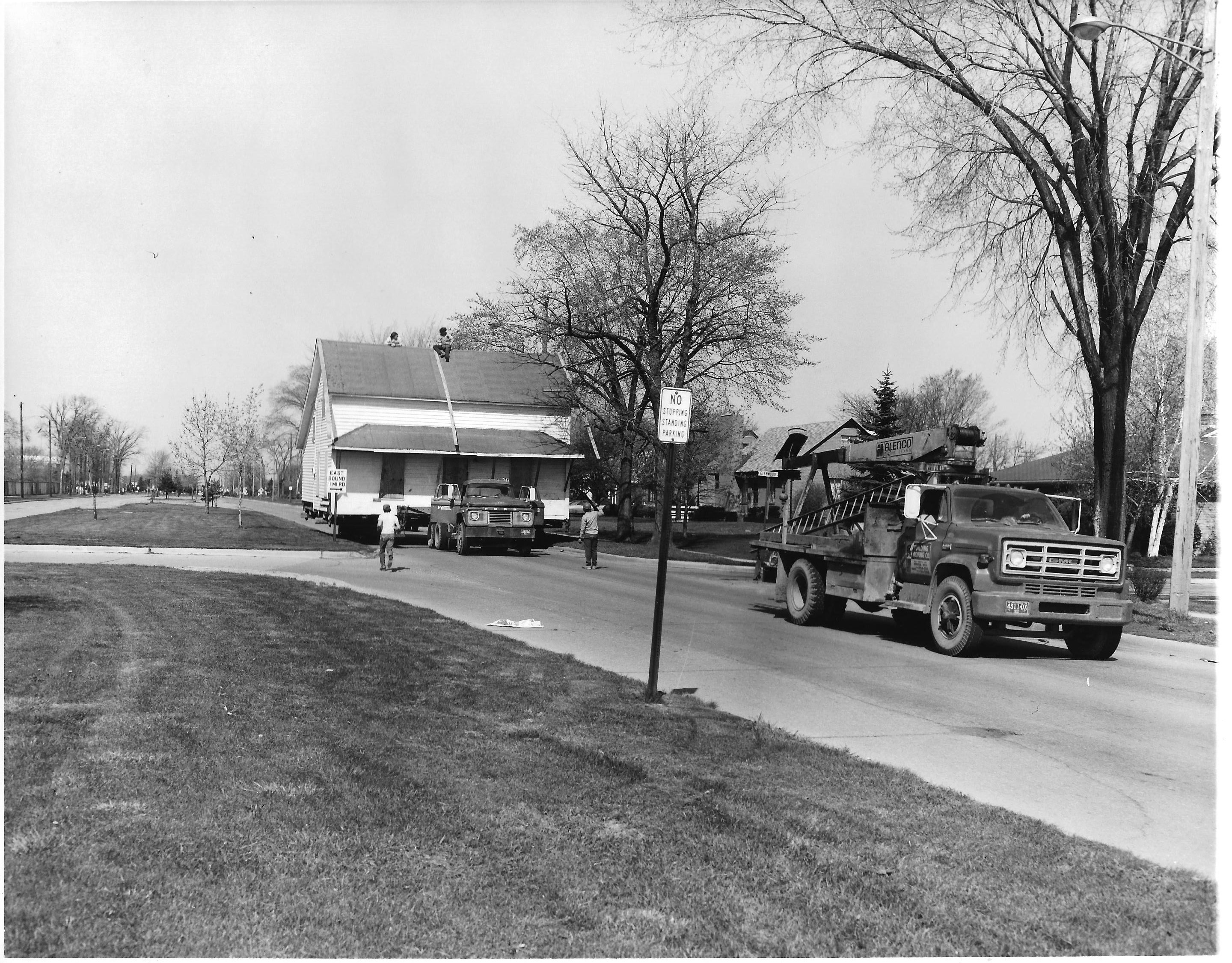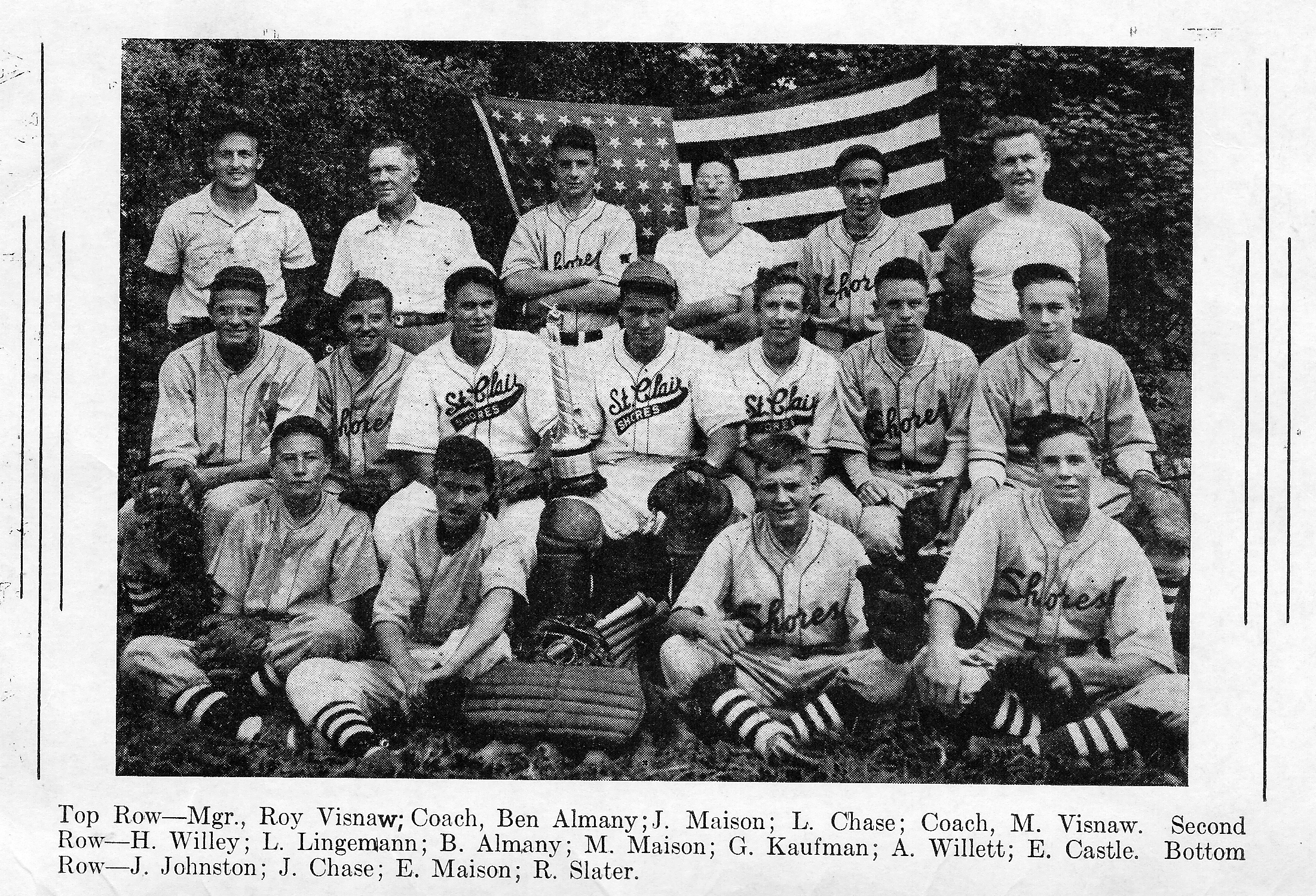——————————————————————————————————————————————————————— |
||||||
——————————————————————————————————————————————————————— |
||||||
Hours of Operation
Monday - Thursday
9:00AM - 9:00PM
Friday - Saturday
9:00AM - 5:00PM
Sunday
Closed
Holiday Hours
Saturday, November 11
Closed
—————————
Looking Back at St. Clair Shores 2018 Articles |
|||||||||||||
Looking Back at St. Clair Shores is a series of historical articles featured most months in the St. Clair Shores Sentinel newspaper. Unless noted otherwise, the photographs used are part of the St. Clair Shores Historical Commision's Photograph Collection. These photographs, along with many others, are available to view through the Digital Media Archive. Previous articles can be found by clicking on the year. |
|||||||||||||
Moving Day for the Selinsky-Green Log House |
|||||||||||||
The preservation and restoration of the Selinsky-Green Log House began in 1974 when the structure was threatened with demolition as a result of the construction of the I-696/I-94 freeway interchange. The building known locally as “the old Green farmhouse” was at the corner of 11 Mile Road and Grant Road in St. Clair Shores. The State of Michigan gave the house to the city; the house had to be moved to be preserved. This photo shows the Log House being moved in 1975 on its way to its new location behind the St. Clair Shores Public Library. John and Mary Selinsky came from Prussia (a part of what is now Germany) to the US in 1859, with their daughter Ernestine. In 1868, the Selinsky’s bought 20 acres of land in what was then Erin Township, in Macomb County, and built a log house. In 1874 Ernestine married John Green and the couple moved into the log house her parents had built. They lived in the house all of their lives, raising six children in the home. After Ernestine’s death in 1937, family members continued to live in the house until 1974. |
|||||||||||||
St. Clair Shores Police Force |
|||||||||||||
| On June 1, 1926, the St. Clair Shores Village Police Force was organized. The department consisted of four men and two motorcycles; the first “office” was in a building at the corner of Jefferson Avenue and 11 Mile Road that housed road maintenance equipment. Within a year, the Force grew: two more men had been added and two Chevrolet cars were provided. The men and their vehicles had also been moved to the Town Hall, which was located at Harper Avenue and 11 Mile Road. Since the police cars did not have radios in the 1920s, two men would patrol the roads and one man was at the police station. Periodically, the men on patrol would stop at various locations and call in to the station for their assignments. By 1928, the police acquired additional cars: two Model A Fords, each capable of going at least 60 miles per hour. The Department also added a resuscitator, to assist those found themselves in distress while swimming or boating on Lake St. Clair. It was not until 1931 that the Force added a vehicle that could be used as an ambulance, or as a paddy wagon, depending on need. In 1933, when this photo was taken, the Force consisted of nine men. Shown in this photo (left to right) are: Police Chief Harold Lanstra and Officers Birdsell Walker, Jim Trombley, Harvey Champine, Harry Olsen, and Hayden Turrell. |
|||||||||||||
The Greendale Inn |
|||||||||||||
The Greendale Inn in St. Clair Shores occupied the space at 27609 Harper Avenue at 11 Mile Road. With its large parking lot, the Greendale presided over the corner from at least 1937, since a phone directory for that year lists the phone number as ROSevl-238. The owners were Leo Delo and Al Witrick. They served meals and they also served drinks. The Inn had a bar, tables, and in the early days, a lunch counter. There was something for everyone in the family at the Greendale Inn: there were gumball machines for the children and slot machines for the adults. The Greendale Inn was typically open by 11 or 11:30 in the morning, and served dinners all day and well into the night. In 1955 the closing hour was midnight; in 1953 closing time had been 1:30 in the morning. In a 1953 area phone book, the ad for the Greendale Inn noted the restaurant was open 7 days, and served beer, wine, and liquor—all of which a patron could also get to go. The ad went on to say the restaurant “specialized in Frankenmuth Dinners”. A sign outside the building with the same advertising is shown in this photograph from the 1940s. With the Frankenmuth dinners, the owners were capitalizing on the popularity of the chicken dinners with several side dishes and dessert in Frankenmuth, which was about 90 miles away. The Greendale Inn closed about 1967; the building no longer exists. |
|||||||||||||
Hilgendorf Service Station |
|||||||||||||
Herman Carl Hilgendorf was born in Bremen, Germany in 1879. In 1884, his family came to the US. By the 1910 census, Hilgendorf was listed as married and working in Detroit. In this photograph from the mid 1930s, Herman Hilgendorf was the station owner (in hat); he is pictured with John Maison and the Maison children, Helen and John Jr. The price shown at the pump was 10 gallons of gas for 95 cents. The first “purpose built” gas station was built in St. Louis, Missouri in 1905. Prior to that, anyone needing gas could purchase it from a local pharmacy, general or hardware store, or even at a blacksmith shop. Once automobiles became more widespread, so did the stations that provided gas. In early pumps similar to the ones shown here, the gasoline was pumped up into a calibrated glass cylinder. Once the desired amount of fuel was in the cylinder, the pump was stopped. A hose was inserted into the vehicle’s gas tank, and gravity pulled the fuel from the pump into the car’s tank. The Hilgendorf Service Station was listed in the 1928 Macomb County phone directory (with the phone number Rosevl-443); the location was Jefferson Avenue at Laukel. Mr. Hilgendorf and his wife Eva and son Aaron lived in a home behind the station, at 22905 Laukel. |
|||||||||||||
Historic Glass House |
|||||||||||||
In 1881 in Pittsburgh, Captain John Ford founded a plate glass company. By 1883, his company was known as the Pittsburgh Plate Glass Company—the first commercially successful plate glass firm in the U.S. The success of the company would shortly end large scale plate glass imports from Europe and foster the growth of the domestic glass industry. Ford’s two sons were involved in the company and by the early 1900s, Emory L. Ford had moved to Detroit. He and his brother were still involved in the glass business as well as with other business ventures, but glass was Emory’s passion. When Emory Ford built a home at 485 Lakeshore Drive in Grosse Pointe in 1916, he made certain to have “glass houses” (what we today call greenhouses) erected on the property. One of those greenhouses is shown here, in the mid 1940s. In 1944, Frank Viviano Sr. paid $2,000 to purchase this glass house. By 1951, it had been re-assembled at the Viviano Flower Shop on Harper Avenue, near Masonic, in St. Clair Shores. Until 1958, the structure was used as a greenhouse, but in 1958 it became a retail area, the purpose that it still serves today. The Emory L. Ford estate was demolished in 1964, but a piece of its glass history lives on in St. Clair Shores. |
|||||||||||||
Schroeder Farm House |
|||||||||||||
Frederick Schroeder and his wife Sophia emigrated from Mecklenburg, Germany in the early 1850s to what was then Erin Township (now St. Clair Shores). In 1865 they purchased 320 acres of property to farm. Their first home was a log house, but about 1870 Schroeder built a new home of brick. Accounts vary, but anywhere from 100,000 to 300,000 bricks were said to have been used in the three-story Victorian style building with the current address of 26717 Little Mack. Frederick Schroeder died in 1895; his wife inherited the house and farm. The Schroeder family lived in the house until the 1920s, when it was rented, and then converted into a road house by Renny Tesoriere. Guests could dance to bands and meals cost 50 or 75 cents. A ballroom was added to the building in 1937. Ruth and Danny DiSanti acquired the building in 1953 and once again changed its use. It became E. C. White’s Old House, a furniture store, pictured here. E. C. White was Ruth’s father, who in 1912 had founded the Gardner-White Furniture Company. Some of the surrounding land continued to be farmed in the 1950s. Sold again in 1986, the building was re-named Victoria Place by its new owners, Ray Domke and Larry Berdasono. The Schroeder house became home to an assortment of shops and a café. Since 2008, the building has been known as Ardmore Park Place, hosting a café, salon, yoga studio, and other enterprises. The one thing that has been consistent is the solid construction of the Schroeder home that has welcomed so many through its doors. Recognizing its history, the St. Clair Shores Historical Commission granted approval of the request for a marker recognizing the history of the building. The marker was dedicated on October 27, 2012. |
|||||||||||||
1954 Fire Truck |
Click the image to view a high resolution version. |
||||||||||||
This is the “delivery photo” that was taken August 23, 1954, the day the new fire truck arrived at the St. Clair Shores Fire Department. It was built on a double chassis for the department by the Fire Master Corporation of Clinton Township. The Village of St. Clair Shores purchased their first two motorized fire engines in 1927. One was kept in a garage at Jefferson and Avon at the “north end” of St. Clair Shores. The other was kept at the “south end” of the Village at Greater Mack and California. Firefighters at that time were unpaid volunteers. By the 1950s there were fire stations on Eleven Mile and Jefferson (just west of Police Headquarters) and at a building just west of the old Post Office at Harper Lake and Greater Mack. These buildings housed three modern engines. In 1956, a new station was built on 13 Mile and Greater Mack and a new fire engine was purchased and housed there. Two additional stations were constructed in 1958. One was built at Sunnydale and Harper, with an iconic “fireman’s pole” for firefighters to slide down from the second floor to the first. The second station was built at Greater Mack and Harper Lake. By that time, the Fire Department employed 63 paid fire fighters and the Chief was Earl K. Dildine, who had started with the Department in 1940. |
|||||||||||||
"The Team of Confidence" Bruce Post V.F.W. Post 1146 St. Clair Shores 1941 Baseball Team |
|||||||||||||
In 1939, Bucky Moore of Mt. Clemens, with the assistance of the American Legion Post, formed a baseball league of six teams: Mt. Clemens, New Haven, Richmond, Van Dyke, Centerline, and St. Clair Shores, to play in the Macomb County American Legion League. The St. Clair Shores team tied with Mt. Clemens for first place that year, but Mt. Clemens received the play off berth due to lack of equipment on the part of St. Clair Shores. “The team ended in a tie …with 1 broken bat and a ball with the cover off.” In 1940, the St. Clair Shores team won championships: the American Legion County Championship, the American Legion 7th Congressional District Championship, the N.Y.A. Championship, the District Championship at Ypsilanti, and they were the runner-up to East Lansing for the State Championship. In all, they won 23 of their 25 games. The boys on the team were 13 to 17 years old, and were “the youngest team of its kind in the State of Michigan…” This photo is on the inside cover of a 1941 souvenir baseball program (cost 10 cents). The program both features the team and served as a fundraising tool. In 1940, the Bruce Post (VFW Post 1146 in St. Clair Shores) paid for all the expenses of the team, including (as the text explained) “travelling expenses, meals, suits, balls, bats and equipment… [in] 1941 the boys are trying to make the team self-supporting…” Shown in the photo are: “Top Row: Mgr., Roy Visnaw; Coach, Ben Almany; J. Maison; L. Chase; Coach, M. Visnaw. Second row: H. Willey; L. Lingemann; B. Almany; M. Maison; G. Kaufman; A. Willett; E. Castle. Bottom Row: J. Johnston; J. Chase; E. Maison; R. Slater.” |
|||||||||||||
Couchez Farm |
|||||||||||||
The Couchez family farmed in the area of St. Clair Shores in the 19th and 20th centuries. An 1895 Macomb County atlas lists at least three farms owned by Couchez family members.Part of the family had emigrated from Belgium in the latter half of the 1800s. This photo from about 1924 shows Edmund Couchez sitting on a wagon with an unidentified boy. The Couchez farm was on Jefferson Avenue, near what is present-day Maple Street in St. Clair Shores.While there is a Couchez Street in the city today, for a time, what is now 13 Mile Road was also known as Couchez. Edmund was born in 1874 in Macomb County.He lived with his parents, Benjamin and Virginia (nee Trombley) until middle age.He married for the first time about two years after this photo was taken, at the age of 51, on April 27, 1926.His wife, the former Ida Sullivan Romzick, was 46 and marrying for the second time.Mr. Couchez died February 23, 1954, and was buried in the St. Gertrude Cemetery. |
|||||||||||||


















